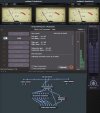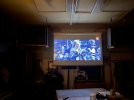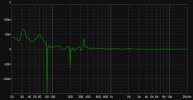fatoldgit
Addicted to Fun and Learning
- Joined
- Feb 29, 2020
- Messages
- 537
- Likes
- 765
Used to spin vinyl and all flavour of silver disc...dropped vinyl, ripped the silver discs and have the following setup. Note the diagram doesnt specifically show the orientation of the side speakers relative to the fronts.. which is part of my "secret sauce" that makes it work.

I have for 20 years run a four channel speaker system (noting all source material is 2 channel)...this is to increase stereo spread in my dedicated room esp for stereo recordings made before pan potting in mixing desks become ubiquitous... which is maybe 80% of my collection... before pan pots the images were placed hard left, hard right and center. Also works well for modern pan potted mixes.
Room is extensively treated with lots of experiments over the years with regard to speaker placement, treatment placement. Room is 8m by 5m.
Nothing funky in play (like using some processor to fake the side channels), just run the side speakers out of phase with the fronts and use the integrated to control the volume balance between front and sides.
This controls the stereo spread I get which I easily change on a per album basis. The streamer provides the master volume.
The image spread is wall to wall... in fact it really forms an arc so has width and depth but all imaging is in front of me... you never hear the sides although they are approximately inline with ears. BUT... its all very natural and not supersized... just the space between everything is spread apart.
Have 5000 ripped CD's (50%/49% split between Blues and Jazz, the rest Rock) and 500 ripped music DVD's (I dont watch movies, tv etc anywhere so the system is purely for music playback).
Peter
I have for 20 years run a four channel speaker system (noting all source material is 2 channel)...this is to increase stereo spread in my dedicated room esp for stereo recordings made before pan potting in mixing desks become ubiquitous... which is maybe 80% of my collection... before pan pots the images were placed hard left, hard right and center. Also works well for modern pan potted mixes.
Room is extensively treated with lots of experiments over the years with regard to speaker placement, treatment placement. Room is 8m by 5m.
Nothing funky in play (like using some processor to fake the side channels), just run the side speakers out of phase with the fronts and use the integrated to control the volume balance between front and sides.
This controls the stereo spread I get which I easily change on a per album basis. The streamer provides the master volume.
The image spread is wall to wall... in fact it really forms an arc so has width and depth but all imaging is in front of me... you never hear the sides although they are approximately inline with ears. BUT... its all very natural and not supersized... just the space between everything is spread apart.
Have 5000 ripped CD's (50%/49% split between Blues and Jazz, the rest Rock) and 500 ripped music DVD's (I dont watch movies, tv etc anywhere so the system is purely for music playback).
Peter

















